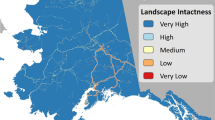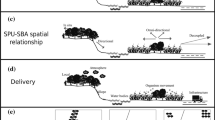Abstract
Context
Conservation planning is increasingly using “coarse filters” based on the idea of conserving “nature’s stage”. One such approach is based on ecosystems and the concept of ecological integrity, although myriad ways exist to measure ecological integrity.
Objectives
To describe our ecosystem-based index of ecological integrity (IEI) and its derivative index of ecological impact (ecoImpact), and illustrate their applications for conservation assessment and planning in the northeastern United States.
Methods
We characterized the biophysical setting of the landscape at the 30 m cell resolution using a parsimonious suite of settings variables. Based on these settings variables and mapped ecosystems, we computed a suite of anthropogenic stressor metrics reflecting intactness (i.e., freedom from anthropogenic stressors) and resiliency metrics (i.e., connectivity to similar neighboring ecological settings), quantile-rescaled them by ecosystem and geographic extent, and combined them in a weighted linear model to create IEI. We used the change in IEI over time under a land use scenario to compute ecoImpact.
Results
We illustrated the calculation of IEI and ecoImpact to compare the ecological integrity consequences of a 70-year projection of urban growth to an alternative scenario involving securing a network of conservation core areas (reserves) from future development.
Conclusions
IEI and ecoImpact offer an effective way to assess ecological integrity across the landscape and examine the potential ecological consequences of alternative land use and land cover scenarios to inform conservation decision making.






Similar content being viewed by others
References
Addicott JF, Aho JM, Antolin MF, Padilla DK, Richardson JS, Soluk DA (1987) Ecological neighborhoods: scaling environmental patterns. Oikos 49:340–346
Anderson M, Clark MG, Sheldon AO (2014) Estimating climate resilience for conservation across geophysical settings. Conserv Biol 28:959–970
Anderson M, Ferree C (2010) Conserving the stage: climate change and the geophysical underpinnings of species diversity. PLoS ONE 5:e11554
Andreasen JK, O’Neill RV, Noss R, Slosser NC (2001) Considerations for the development of a terrestrial index of ecological interity. Ecol Ind 1:21–35
Beazley KF, Baldwin ED, Reining C (2010) Integrating expert judgment into systematic ecoregional conservation planning. In: Trombulak S, Baldwin R (eds) Landscape-scale conservation planning. Springer, Dordrecht, pp 235–255
Beier P (2012) Conceptualizing and designing corridors for climate change. Ecol Restor 30:312–319
Beier P, Brost B (2010) Use of land facets to plan for climate change: conserving the arenas, not the actors. Conserv Biol 24:701–710
Beier P, Hunter ML, Anderson M (2015) Special section: conserving nature’s stage. Conserv Biol 29:613–617
Belote RT, Dietz MS, Jenkins CN, McKinley PS, Irwin GH, Fullman TJ, Leppi JC, Aplet GH (2017) Wild, connected, and diverse: building a more resilient system of protected areas. Ecol Appl 27:1050–1056
Briers RA (2002) Incorporating connectivity into reserve selection procedures. Biol Cons 103:77–83
Brown ED, Williams BK (2016) Ecological integrity assessment as a metric of biodiversity: are we measuring what we say we are? Biodivers Conserv 25:1011–1035
Ceballos G, Ehrlich PR, Barnosky AD, Garcia A, Pringle RM, Palmer TM (2015) Accelerated modern human-induced species losses: entering the sixth mass extinction. Sci Adv 1:1–5
Cerdeira JO, Gaston KJ, Pinto LS (2005) Connectivity in priority area selection for conservation. Environ Model Assess 10:183–192
Compton BW, McGarigal K, Cushman SA, Gamble LR (2007) A resistant-kernel model of connectivity for amphibians that breed in vernal pools. Conserv Biol 21:788–799
DeNormandie J, Corcoran C (2009) Losing ground beyond the footprint: patterns of development and their impact on the nature of Massachusetts. Fourth Edition of the Losing Ground Series, MassAudubon (http://www.massaudubon.org/content/download/8601/149722/file/LosingGround_print.pdf)
Forman RTT, Sperling D, Bissonette JA, Clevenger AP, Cutshall CD, Dale VH, Fahrig L, France R, Goldman CR, Heanue K, Jones JA, Swanson FJ, Turrentine T, Winter TC (2003) Road ecology. Island Press, Covelo, CA, Science and Solutions, p 504
Gunderson LH (2000) Ecological resilience—in theory and application. Annu Rev Ecol Syst 31:425–439
Haddad NM, Brudvig LA, Clobert J, Davies KF, Gonzalez A, Holt RD, Lovejoy TE, Sexton JO, Austin MP, Collins CD, Cook WM, Damschen EI, Ewers RM, Foster BL, Jenkins CN, King AJ, Laurance WF, Levey DJ, Margules CR, Melbourne BA, Nicholls AO, Orrock JL, Song D-X, Townshend JR (2015) Habitat fragmentation and its lasting impact on Earth’s ecosystems. Sci Adv 1:e1500052
Holling CS (1973) Resilience and stability of ecological systems. Annu Rev Ecol Syst 4:1–23
Holling CS (1996) Engineering resilience versus ecological resilience. In: Schulze PC (ed) Engineering within ecological constraints. National Academy Press, Washington, D.C, USA
Hunter ML Jr, Jacobson GL, Webb T III (1988) Paleoecology and the coarse-filter approach to maintaining biological diversity. Conserv Biol 2:375–385
Lentz EE, Stippa SR, Thieler ER, Plant NG, Gesch DB, Horton RM (2015) Evaluating coastal landscape response to sea-level rise in the northeastern United States—approach and methods: U.S. Geological Survey Open-File Report 2014–1252, p 26. http://dx.doi.org/10.3133/ofr20141252 ISSN 2331–1258 (online)
Lerner J, Mackey J, Casey F (2007) What’s in Noah’s wallet? Land conservation spending in the United States. Bioscience 57:419–423
McGarigal K, Plunkett EB, Grand J, Compton BW, Portante T, Rolih K, Jackson SD (2013) Empirically derived indices of biotic integrity for forested wetlands, coastal salt marshes and wadable freshwaters streams in Massachusetts. Report to Massachusetts Department of Environmental Protection, September 15, 2013, p 249
McGarigal K, Compton BW, Plunkett EB, Deluca WV Grand J (2017) Designing sustainable landscapes project: documents and data products. https://scholarworks.umass.edu/designing_sustainable_landscapes/
McGarigal K, Plunkett EB, Willey L, Compton BW, DeLuca WV, Grand J (2018) Modelling urban growth in the northeastern United States: the SPRAWL model and the ecological impacts of urban growth. Ecol Model 177:178–190
Newbold T, Hudson LN, Hill SLL, Contu S, Lysenko I, Senior RA, Börger L, Bennett DJ, Choimes A, Collen B, Day J, De Palma A, Díaz S, Echeverria-Londoño S, Edgar MJ, Feldman A, Garon M, Harrison MLK, Alhusseini T, Ingram DJ, Itescu Y, Kattge J, Kemp V, Kirkpatrick L, Kleyer M, Correia DLP, Martin CD, Meiri S, Novosolov M, Pan Y, Phillips HRP, Purves DW, Robinson A, Simpson J, Tuck SL, Weiher E, White HJ, Ewers RM, Mace GM, Scharlemann JPW, Purvis A (2015) Global effects of land use on local terrestrial biodiversity. Nature 520:45–50
Noss R (1996) Ecosystems as conservation targets. Trends Ecol Evol 11:351
Ortega-Huerta MA, Peterson AT (2004) Modelling spatial patterns of biodiversity for conservation prioritization in North-eastern Mexico. Divers Distrib 10:39–54
Parrish JD, Braun DP, Unnassch RS (2003) Are we conserving what we say we are? Meas Ecol Integr Prot Areas 53:851–860
Pereira HM, Leadley PW, Proenca V, Alkemade R, Scharlemann JPW, Fernandez-Manjarres JF, Araujo MB, Balvanera P, Biggs R, Cheung WWL, Chini L, Cooper HD, Gilman EL, Guenette S, Hurtt GC, Huntington HP, Mace GM, Oberdorff T, Revenga C, Rodrigues P, Scholes RJ, Sumaila UR, Walpole M (2010) Scenarios for global biodiversity in the 21st century. Science 330:1496–1501
Pickett STA, Parker VT, Fiedler PL (1992) The new paradigm in ecology: implications for conservation above the species level. In: Fiedler PL, Jain SK (eds) Conservation biology: theory and practice of nature conservation and management. Chapman and Hall Press, New York, pp 65–88
Pimm SL, Russell GJ, Gittleman JL, Brooks TM (1995) The future of biodiversity. Science 269:347–350
Randhir TO, O’Connor R, Penner PR, Goodwin DW (2001) A watershed-based land prioritization model for water supply protection. For Ecol Manag 143:47–56
Sala OE, Chapin FC III, Armesto JJ, Berlow E, Bloomfield J, Dirzo R, Huber-Sanwald E, Huenneke LF, Jackson RB, Kinzig A, Leemans R, Lodge DM, Mooney HA, Oesterheld M, Poff NL, Sykes MT, Walker BH, Walker M, Wall DH (2000) Global biodiversity scenarios for the year 2100. Science 287:1770–1774
Sanderson EW, Jaiteh M, Levy MA, Redford KH, Wannebo AV, Woolmer G (2002) The human footprint and the last of the wild. Bioscience 52:891–904
Scott JM, Davis F, Csuti B, Noss R, Butterfield B, Groves C, Anderson H, Caicco S, D’Erchia F, Edwards TC Jr, Ulliman J, Wright RG (1993) GAP analysis: a geographic approach to protection of biological diversity. Wildl Monogr 123:1–41
Silverman BW (1986) Density estimation for statistics and data analysis. Chapman & Hall, London
Soulé ME, Terborgh J (eds) (1999) Continental conservation: scientific foundations of regional reserve networks. Island Press, Washington, DC
Theobald DM (2013) A general model to quantify ecological integrity for landscape assessments and US application. Landscape Ecol 28:1859–1874
Tierney GL, Faber-Langendoen D, Mitchell BR, Shriver WG, Gibbs JP (2009) Monitoring and evaluating the ecological integrity of forest ecosystems. Front Ecol Environ 7:308–316
Turner MG, Gardner RH (2015) Landscape ecology in theory and practice. Springer, New York, p 482
Venter O, Sanderson EW, Magrach A, Allan JR, BeherJ Jones KR, Possingham HP, Laurance WF, Wood P, Fekete BM, Levy MA, Watson JEM (2016) Sixteen years of change in the global terrestrial human footprint and implications for biodiversity conservation. Nat Commun 7:12558
Williams PH, Margules CR, Hilbert DW (2002) Data requirements and data sources for biodiversity priority area selection. J Biosci 27:327–338
Wurtzebach Z, Schultz C (2016) Measuring ecological integrity: history, practical applications, and research opportunities. Bioscience 66:446–457
Zeller KA, McGarigal K, Whiteley AR (2012) Estimating landscape resistance to movement: a review. Landscape Ecol 27:777–797
Acknowledgements
This work was supported by the United States Fish and Wildlife Service, North Atlantic Landscape Conservation Cooperative (NALCC), US Geological Survey Northeast Climate Science Center, Massachusetts Executive Office of Environmental Affairs, The Trustees of Reservations, Massachusetts Department of Environmental Protection, The Nature Conservancy, US Department of Transportation, and the University of Massachusetts, Amherst. We especially thank Andrew Milliken and Scott Schwenk of the NALCC for their continued support and close involvement in several conservation applications involving the DSL project and the use of IEI.
Author information
Authors and Affiliations
Corresponding author
Electronic supplementary material
Below is the link to the electronic supplementary material.
Rights and permissions
About this article
Cite this article
McGarigal, K., Compton, B.W., Plunkett, E.B. et al. A landscape index of ecological integrity to inform landscape conservation. Landscape Ecol 33, 1029–1048 (2018). https://doi.org/10.1007/s10980-018-0653-9
Received:
Accepted:
Published:
Issue Date:
DOI: https://doi.org/10.1007/s10980-018-0653-9




